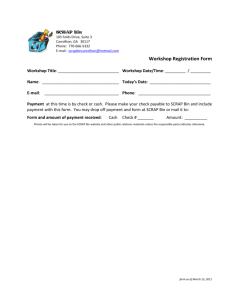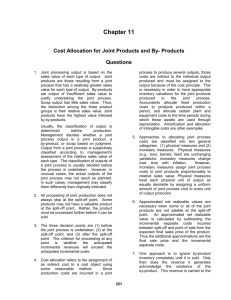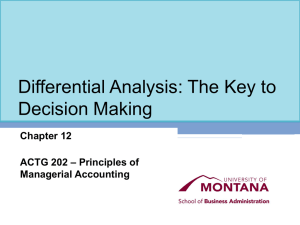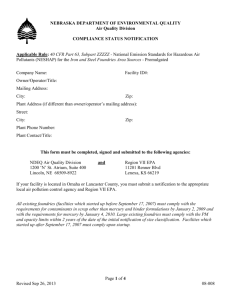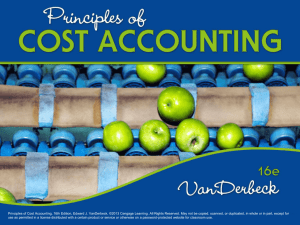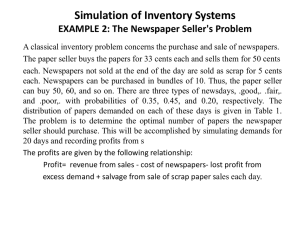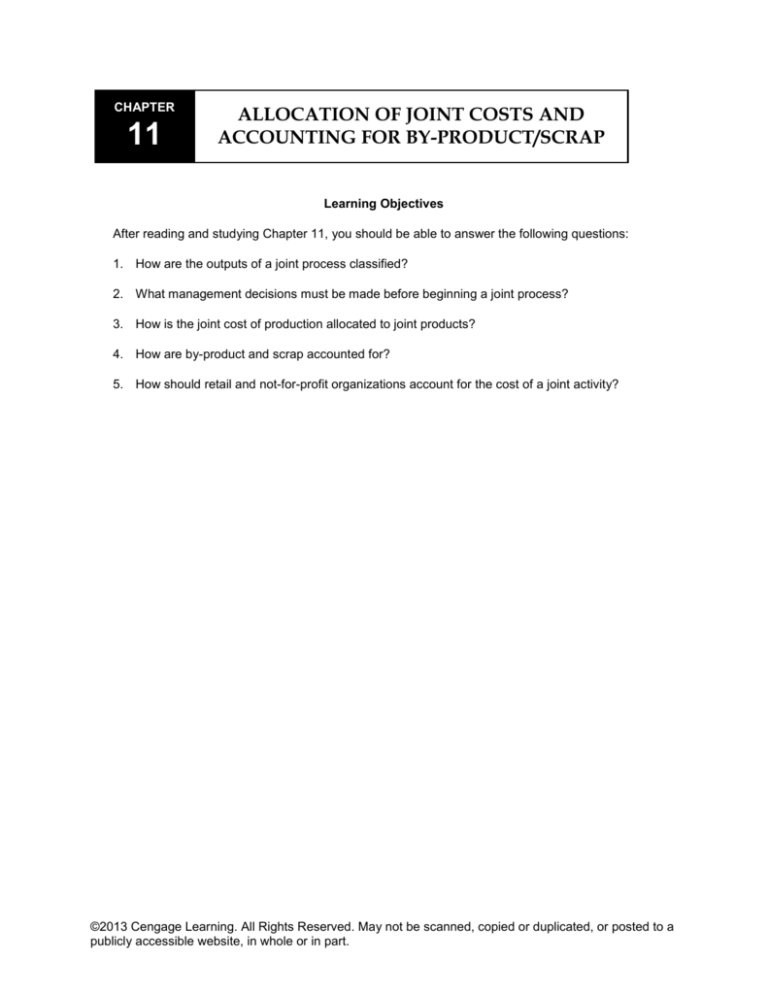
CHAPTER
11
ALLOCATION OF JOINT COSTS AND
ACCOUNTING FOR BY-PRODUCT/SCRAP
Learning Objectives
After reading and studying Chapter 11, you should be able to answer the following questions:
1. How are the outputs of a joint process classified?
2. What management decisions must be made before beginning a joint process?
3. How is the joint cost of production allocated to joint products?
4. How are by-product and scrap accounted for?
5. How should retail and not-for-profit organizations account for the cost of a joint activity?
©2013 Cengage Learning. All Rights Reserved. May not be scanned, copied or duplicated, or posted to a
publicly accessible website, in whole or in part.
Chapter 11: Allocation of Joint Costs and Accounting for By-Product/Scrap
IM 2
Terminology
Approximated net realizable value at split-off allocation: a method of allocating joint costs to joint
products using a simulated net realizable value at the split-off point; approximated value is computed as
final sales price minus incremental separate costs
By-product: an incidental output of a joint process; it is salable, but the sales value is not substantial
enough for management to justify undertaking the joint process; it is viewed as having a higher sales
value than scrap
Joint costs: costs incurred for material, labor, and overhead during a joint process up to the split-off point
Joint process: a process during which one product cannot be manufactured without producing others
Joint product: a primary output of a joint process; each joint product individually has substantial
revenue-generating ability
Net realizable value (NRV): an amount equal to the product’s sales revenue at split-off less preparation
and disposal costs
Net realizable value approach: a method of accounting for by-products or scrap that requires that the
net realizable value of these products be treated as a reduction in the cost of the primary products
Net realizable value at split-off allocation: a method of assigning joint costs to joint products based on
the sales value at split-off minus all costs necessary to prepare and dispose of the products; it requires
that all joint products be salable at the split-off point
Offset approach: (see net realizable value approach)
Other income approach: (see realized value approach)
Physical measure allocation: a method of allocating a joint cost to products that uses a common
physical characteristic as the proration base
Realized value approach: a method of accounting for by-products or scrap that does not recognize any
value for these products until they are sold; the value recognized upon sale can be treated as other
revenue or income
Sales value at split-off allocation: a method of assigning joint costs to joint products based on the
relative sales value of the products at the split-off point as the proration base; use of this method requires
that all joint products be salable at the split-off point
Scrap: an incidental output of a joint process; it is salable but the sales value from scrap is not enough for
management to justify undertaking the joint process; it is viewed as having a lower sales value than a byproduct; leftover material that has a minimal but distinguishable disposal value
Separate costs: costs incurred in later stages of production that are assignable to specific primary
products
Split-off point: the point at which the outputs of a joint process are first identifiable as individual products
Waste: a residual output of a production process that has no sales value
©2013 Cengage Learning. All Rights Reserved. May not be scanned, copied or duplicated, or posted to a
publicly accessible website, in whole or in part.
Chapter 11: Allocation of Joint Costs and Accounting for By-Product/Scrap
IM 3
Lecture Outline
LO.1: How are the outputs of a joint process classified?
A. Introduction
1. Many companies produce and sell multiple products.
2. A joint process is a manufacturing process that simultaneously produces more than one product
line.
a. Classification of joint process output is based on management judgment about the relative
sales value of the outputs and can vary from company to company.
3. Joint cost refers to the costs incurred for material, labor, and overhead during a joint process up
to the split-off point.
a. Although joint costs must be allocated to the primary products to determine financial
statement valuations, such allocations should not be used in making internal decisions.
4. Separate costs are costs incurred in later stages of production that are assignable to specific
primary products.
5. This chapter discusses joint manufacturing processes, their related product outputs, and the
accounting treatment of the costs of those processes.
B. Outputs of a Joint Process
1. The products resulting from a joint process and having a sales value are classified as joint
products, by-products, or scrap.
2. Joint products are the primary outputs of a joint process, each of which has substantial revenuegenerating ability.
a. Joint products are also called primary products, main products, and co-products.
3. By-products are incidental outputs of a joint process; they are salable, but the sales value of byproducts is not substantial enough for management to justify undertaking the joint process; they
are viewed as having a higher sales value than scrap.
4. Scrap is an incidental output of a joint process; it is salable, but the sales value from scrap is not
enough for management to justify undertaking the joint process; it is viewed as having a lower
sales value than a by-product; leftover material that has a minimal but distinguishable disposal
value.
5. Waste is a residual output of a production process that must be disposed of because it has no
sales value.
6. Over time, a product classification may change because of technology advances, consumer
demand, or ecological factors.
©2013 Cengage Learning. All Rights Reserved. May not be scanned, copied or duplicated, or posted to a
publicly accessible website, in whole or in part.
Chapter 11: Allocation of Joint Costs and Accounting for By-Product/Scrap
IM 4
a. New joint products may be developed from a product as illustrated in text Exhibit 11.1 (p.
435) for soybeans.
b. Joint process output is classified based on management’s judgment about the relative sales
values of outputs.
C. The Joint Process
1. Joint products are typically manufactured in companies using mass production processes and a
process costing accounting method.
a. Text Exhibit 11.2 (p. 436) describes the outputs produced from steer processing.
2. The split-off point is the point at which the outputs of a joint process are first identifiable as
individual products.
3. Financial reporting requires that all necessary and reasonable costs of production be attached to
products.
a. Joint costs must be allocated to the primary outputs of the production process for inventory
valuation purposes.
4. Costs incurred after split-off are assigned to the separate products for which those costs are
incurred.
a. Text Exhibit 11.3 (p. 437) illustrates a joint process with multiple split-off points and the
allocation of costs to products.
b. Allocated joint costs should not be used in making decisions about further processing of joint
products.
LO.2: What management decisions must be made before beginning a joint process?
D. The Joint Process Decision
1. Text Exhibit 11.4 (p. 439) presents the four management decision points in a joint production
process:
a. Management must decide whether the total expected revenues from the sale of the joint
process output are likely to exceed the total expected processing costs of the output. Other
potential costs must be considered in determining if the revenues are expected to exceed the
costs;
b. Managers must compare the net income from this use of resources to the net income that
would be provided by all other alternative uses of company resources if total anticipated
revenues from the “basket” of products exceed the anticipated joint and separate costs.
Management would then decide that this joint production process is the best use of capacity
and would begin production if joint process net income is greater than the net income that
would be provided by other uses;
c.
Management must decide how to classify joint process outputs; and
©2013 Cengage Learning. All Rights Reserved. May not be scanned, copied or duplicated, or posted to a
publicly accessible website, in whole or in part.
Chapter 11: Allocation of Joint Costs and Accounting for By-Product/Scrap
i.
IM 5
Some will be primary; others will be by-product, scrap, or waste.
d. Management must then decide whether any (or all) of the joint process output will be sold (if
marketable) at split-off or whether it will be processed further.
i.
Such decisions should be made only after considering whether the expected additional
revenues from further processing are higher than the expected additional costs of further
processing.
2. Managers must have a reasonable estimate of each joint output’s selling price in order to make
decisions at any potential point of sale. Expected selling prices should be based on both cost and
market factors.
LO.3: How is the joint cost of production allocated to joint products?
E. Allocation of Joint Cost
1. Text Exhibit 11.5 (p. 440) provides data for Gobble Gobble, a company that manufactures three
primary products from a joint process. This case is used in the chapter to demonstrate alternative
methods of allocating joint processing costs.
2. Physical measure allocation
a. Physical measure allocation is a method of allocating common costs to products that uses
a common physical characteristic as the proration base.
b. Physical measurement allocation, unlike monetary measure allocation, provides an
unchanging yardstick of output.
c.
Physical measures are useful in allocating joint cost to products that have extremely unstable
selling prices.
d. A primary disadvantage of the method is that it ignores the revenue-generating ability of
individual joint products.
e. This allocation process treats each weight unit of output as equally desirable and assigns
each the same per unit cost.
f.
Text Exhibit 11.6 (p. 441) illustrates this method of allocation.
i.
Journal entries for incurring the joint processing cost, allocating it to the joint products,
and recognizing the separate processing cost are provided in the text immediately
following the exhibit.
3. Monetary measure allocation
a. General
i.
The primary benefit of monetary over physical measure allocations is that the monetary
measure approach recognizes the relative ability of each product to generate a profit at
sale.
ii.
A problem with monetary measure allocations is that the basis used is dynamic.
©2013 Cengage Learning. All Rights Reserved. May not be scanned, copied or duplicated, or posted to a
publicly accessible website, in whole or in part.
Chapter 11: Allocation of Joint Costs and Accounting for By-Product/Scrap
IM 6
Accountants customarily ignore price-level fluctuations.
iii. Monetary measure allocation uses the following steps to prorate joint costs to joint
products:
Step 1: Choose a monetary allocation base;
Step 2: List each product’s base values;
Step 3: Sum the values in step 2 to obtain a total value for the list;
Step 4: Divide each individual value in step 2 by the total in step 3 to obtain a
numerical proportion for each product. (The sum of these proportions should total
100 percent);
Step 5: Multiply the joint cost by each proportion to obtain the amount to be allocated
to each product; and
Step 6: Divide each product’s prorated joint cost by the number of product units to
obtain a cost per unit for valuation purposes.
b. Sales value at split-off
i.
The sales value at split-off allocation is a method of assigning joint cost to joint
products based on the relative sales values of the products at the split-off point.
ii.
Use of this method requires that all joint products are marketable at split-off.
iii. Text Exhibit 11.7 (p. 442) illustrates this method of allocation.
c.
Journal entries are similar to those illustrated earlier.
Net realizable value at split-off
i.
The net realizable value at split-off allocation is a method of allocating joint cost to
joint products based on the sales value at split-off minus all costs necessary to prepare
and dispose of the products.
ii.
Use of this method requires that all joint products be salable at split-off.
iii. Text Exhibit 11.8 (p. 443) illustrates this method of allocation.
d. Approximated net realizable value at split-off
i.
The approximated net realizable value at split-off allocation is a method of allocating
joint cost to joint products that uses a simulated net realizable value at the split-off point.
ii.
Approximated value is computed as final sales price minus incremental separate costs.
Thus, decisions made about further processing affect the values used to allocate joint
cost under this method.
©2013 Cengage Learning. All Rights Reserved. May not be scanned, copied or duplicated, or posted to a
publicly accessible website, in whole or in part.
Chapter 11: Allocation of Joint Costs and Accounting for By-Product/Scrap
IM 7
iii. An underlying assumption of this method is that the incremental revenue from further
processing is equal to or greater than the incremental costs of further processing.
iv. Text Exhibit 11.9 (p. 444) illustrates this method of allocation.
v.
Text Exhibit 11.10 (p 445) shows that the example company can process some joint
products further to create additional types of output. However, this further processing
does not change the allocation of joint cost previously made to the joint products.
4. In summary:
a. Each method discussed allocates a different amount of joint cost to the joint products and
results in a different per-unit cost for each product and, accordingly, has its own advantages
and disadvantages; and
b. For most companies, approximated NRV at split-off provides the most logical joint cost
assignment.
i.
This is because, for each joint product, approximated NRV captures the intended level of
separate processing, costs of separate processing, expected selling costs of each joint
product, and the expected selling price of each joint product. Thus, approximated NRV is
the best measure of the expected contribution of each product line to the coverage of
joint costs.
ii.
The method is, however, more complex than the other methods because estimations
must be made about additional processing costs and potential future sales values.
LO.4: How are by-product and scrap accounted for?
F. Accounting for By-Product and Scrap
1. General
a. Because the distinction between by-product and scrap is one of degree, these categories are
discussed together by presenting several of the treatments found in practice.
i.
The appropriate choice of method depends on the magnitude of the net realizable value
of the item and the need for additional processing beyond split-off.
b. As the sales value of the by-product increases, so does the need for inventory recognition.
i.
c.
Sales value of the by-product is generally recorded under either the NRV approach or
realized value approach.
Text Exhibit 11.11 (P. 446) provides data for a by-product that is produced by Gobble
Gobble.
2. Net realizable value (NRV) approach
a. The net realizable value approach (or offset approach) is a method of accounting for byproducts or scrap that requires the net realizable value of such products to be treated as a
reduction in the cost of the primary products.
©2013 Cengage Learning. All Rights Reserved. May not be scanned, copied or duplicated, or posted to a
publicly accessible website, in whole or in part.
Chapter 11: Allocation of Joint Costs and Accounting for By-Product/Scrap
IM 8
b. The NRV is debited to inventory and one of two accounts may be credited: WIP Inventory –
Joint Products or Cost of Goods Sold.
c.
Although reducing joint cost by the NRV of the by-product/scrap is the traditional method
used to account for such goods, it is not necessarily the best method for internal decision
making or the management of by-products/scrap.
i.
The NRV method does not indicate the revenues, expenses, or profits from the byproduct and thus does not provide sufficient information for managerial decision making.
d. Text Exhibit 11.12 (p. 447) shows two comparative income statements using both NRV
methods of accounting for the by-product/scrap income for the example company.
3. Realized value approach
a. When management considers by-product/scrap to be a moderate source of income, the
accounting and reporting methods used should help managers monitor production and further
processing of the by-product/scrap.
b. The realized value approach (or other income approach) is a method of accounting for byproduct/scrap that does not recognize any value for these products until they are sold; the
value recognized at the time of sale can be treated as other revenue or as other income.
c.
The total sales price of the by-product/scrap is shown on the income statement as other
revenue under the “other revenue” method.
i.
Additional processing or disposal costs of the by-product/scrap are included with the cost
of producing the primary products, so little useful information is provided to management
since the cost of producing the by-product/scrap is not matched with the revenues
generated by those items.
d. The net by-product revenue is presented as an enhancement of net income in the period of
sale as “other income” under the “other income” method.
i.
By-product/scrap revenue is matched with related storage, further processing,
transportation, and disposal costs.
ii.
Since detailed information on financial responsibility and accountability is provided,
control and performance may be improved.
e. Text Exhibit 11.13 (p. 449) shows two comparative income statements using both realized
value methods of accounting for the by-product/scrap income for the example company.
4. With the trend toward more emphasis on cost and quality control, companies are becoming more
aware of the potential value of by-product, scrap, and waste and are devoting time and attention
to developing those innovative revenue sources.
G. By-Product and Scrap in Job Order Costing
1. Job order costing systems can have by-products or scrap even though joint products are not
normally associated with such systems.
©2013 Cengage Learning. All Rights Reserved. May not be scanned, copied or duplicated, or posted to a
publicly accessible website, in whole or in part.
Chapter 11: Allocation of Joint Costs and Accounting for By-Product/Scrap
IM 9
2. The value of by-product/scrap in a job order costing system should be credited to manufacturing
overhead if the by-products/scrap value is created by a significant proportion of all jobs
undertaken.
3. The by-product/scrap value, in contrast, can be credited to the specific jobs in process if only a
few specific jobs generate a disproportionate share of the by-products/scrap.
LO.5: How should retail and not-for-profit organizations account for the cost of a joint activity?
H. Joint Costs in Retail Businesses and Not-for-Profit Organizations
1. Joint costs in retail businesses and not-for-profit (NFP) organizations often do not relate to
production processes but to marketing and promotion activities such as:
a. advertising multiple products;
b. printing multipurpose documents; or
c.
holding multipurpose events.
2. Retail businesses may allocate joint costs using either a physical or monetary base.
a. Joint costs for retail businesses usually relate to advertisements rather than to a process.
b. Retail businesses may decide it is not necessary to allocate joint costs.
3. Although retail businesses may decide that allocating joint cost is not necessary, financial
accounting requires that not-for-profit organizations allocate joint costs among the activities of
fund-raising, offering an organizational program (program activities), or conducting an
administrative function (management and general activities).
4. No specific allocation method is prescribed; only that the method used must be rational and
systematic, result in reasonable allocations, and be applied in the same manner under similar
situations.
a. A major purpose of this allocation process is to ensure that external users of financial
statements are able to determine clearly the amounts spent by the organization for various
activities—especially fundraising.
5. There are three tests that must be met for allocation; if all the tests are not met, all the costs
associated with the joint activity must be charged to fundraising:
a. The purpose test must demonstrate that the activity’s purpose includes accomplishing some
program or management/general function.
i.
A critical element under the purpose test is the compensation test. If a majority of
compensation or fees for anyone performing a part of the activity is tied to contributions
raised, the activity automatically fails the purpose criterion and all costs of the activity
must be charged to fundraising.
b. The audience test must demonstrate that the NFP chose the audience because it is suitable
for accomplishing the activity’s program or management/general functions.
©2013 Cengage Learning. All Rights Reserved. May not be scanned, copied or duplicated, or posted to a
publicly accessible website, in whole or in part.
Chapter 11: Allocation of Joint Costs and Accounting for By-Product/Scrap
c.
IM 10
The content test must demonstrate that the activity’s content supports program or
management/general functions.
©2013 Cengage Learning. All Rights Reserved. May not be scanned, copied or duplicated, or posted to a
publicly accessible website, in whole or in part.
Chapter 11: Allocation of Joint Costs and Accounting for By-Product/Scrap
IM 11
Multiple Choice Questions
1. (LO.1) A product that results from a joint process may be classified as
a. a joint product.
b. a by-product.
c. scrap.
d. All of the above.
2. (LO.1) Select the incorrect statement from the following.
a. Producing first-quality merchandise and factory seconds in a single operation can be viewed
as a joint process.
b. Waste is a residual output from many production processes whose sales value is comparable
to that of by-products.
c. By-products are distinguished from scrap by their higher sales value.
d. While joint cost allocations are necessary to determine financial statement valuations, such
allocations should not be used in making internal decisions.
3. (LO.1) Select the incorrect statement concerning the split-off point.
a. The split-off point is the point at which joint process outputs are first identifiable as individual
products.
b. If joint output is processed beyond the split-off point, additional costs will be incurred and
must be assigned to the specific products for which those costs were incurred.
c. A single joint process cannot have multiple spit-off points.
d. Output may be sold at the split-off point or processed further and then sold.
4. (LO.2) In joint product costing and analysis, which one of the following costs is relevant when
deciding the point at which a product should be sold in order to maximize profits?
a. Purchase costs of the materials required for the joint products
b. Separable costs after the split-off point
c. Joint costs to the split-off point
d. Sales salaries for the period when the units were produced
5. (LO.2) Before committing resources to a joint process, management must first decide whether
total expected revenue from selling the joint output ‘basket’ of products is likely to exceed the:
a. selling expenses for the goods.
b. joint costs and separate processing costs after split-off.
c. disposal costs for any waste generated.
d. All of the above.
6. (LO.2) When estimating unit selling prices for use in allocating joint production costs, which of the
following should be considered?
a. Competitor prices
b. Consumers’ sensitivity to price changes
c. Costs
d. All of the above
7. (LO.3) All of the following are common monetary measures for allocating joint costs to joint
products except:
a. approximated net realizable value at split-off.
b. gross margin at split-off.
c. net realizable value at split-off.
d. sales value at split-off.
©2013 Cengage Learning. All Rights Reserved. May not be scanned, copied or duplicated, or posted to a
publicly accessible website, in whole or in part.
Chapter 11: Allocation of Joint Costs and Accounting for By-Product/Scrap
IM 12
8. (LO.3) LS Company manufactures two products, Product L and Product S in a joint process. The
joint (common) costs incurred are $420,000 for a standard production run that generates 180,000
units of L and 120,000 units of S. Product L sells for $2.40 per unit while Product S sells for $3.90
per unit. Assuming both products are sold at the split-off point, the amount of joint cost of each
production run allocated to Product L on a net realizable value (NRV) basis is:
a. $252,000.
b. $218,400.
c. $201,600.
d. $168,000.
9. (LO.3) Products A and B are manufactured in a joint process. The joint (common) costs incurred
are $252,000 for a standard production run that generates 108,000 gallons of Product A which
sells for $2.40 per gallon and 72,000 gallons of Product B which sells for $3.90 per gallon. If no
additional costs are incurred after the split-off point, the amount of joint cost of each production
run allocated to Product B on a physical measure basis is:
a. $100,800.
b. $140,000.
c. $151,200.
d. $280,800.
10. (LO.3) Products X and Y are manufactured in a joint process. The joint (common) costs incurred
are $420,000 for a standard production run that generates 180,000 gallons of Product X which
sells for $2.40 per gallon and 120,000 gallons of Product Y which sells for $3.90 per gallon. If
additional processing costs beyond the split-off point are $1.40 per gallon for Product X and $0.90
per gallon for Product Y, the amount of joint cost allocated to Product Y on a net realizable value
basis is:
a. $280,000.
b. $252,000.
c. $168,000.
d. $140,000.
11. (LO.3) M Company incurs $10,000,000 in joint costs for its three products. The company
estimates the products’ production, final selling price, and separate costs after split-off as follows:
Product
Product A
Product B
Product C
Production
3,000
2,400
1,200
Estimated
Selling Price
$2,000
$3,000
$1,500
Estimated
Separate Cost
$200
$500
$100
How much of the joint costs should be allocated to Product A under the approximated net
realizable value at split-off? (Note: round percentages to zero decimal places.)
a. $4,600,000
b. $4,100,000
c. $1,300,000
d. None of the above
©2013 Cengage Learning. All Rights Reserved. May not be scanned, copied or duplicated, or posted to a
publicly accessible website, in whole or in part.
Chapter 11: Allocation of Joint Costs and Accounting for By-Product/Scrap
IM 13
12. (LO.4) P Inc. always generates a certain amount of waste due to the nature of its production
activities regardless of which products it is producing at the time. After production in a recent
month, the company sold $200 of scrap. Which of the following is the correct entry to record the
sale of the scrap using the realized value approach?
a. Cash
200
Manufacturing Overhead
200
b. Cash
200
Finished Goods
200
c. Cash
200
Scrap Inventory
200
d. Cash
200
Work in Process
200
13. (LO.4) Select the incorrect statement concerning the accounting for by-product and scrap.
a. Reducing joint cost by the NRV of the by-product/scrap is the traditional method used to
account for such goods.
b. Regardless of whether a company uses the NRV or the realized value approach, the specific
method used to account for by-product should be established before the joint cost is allocated
to the joint products.
c. Two common methods used to account for by-products are the NRV approach and the
realized value approach.
d. Under the realized value approach, the estimated selling price of the by-product is recognized
prior its actual sale.
14. (LO.5) Not-for-profit organizations may charge the entire cost of a joint activity to fund-raising if all
of the following criteria are met except:
a. amount.
b. audience.
c. content.
d. purpose.
15. (LO.5) If a majority of compensation or fees for anyone performing a part of an activity is tied to
contributions raised, the activity automatically fails the
a. purpose criterion and all costs of the activity must be charged to program activities.
b. content criterion and all costs of the activity must be charged to fund-raising.
c. purpose criterion and all costs of the activity must be charged to fund-raising.
d. audience criterion and all costs of the activity must be charged to administrative activities.
©2013 Cengage Learning. All Rights Reserved. May not be scanned, copied or duplicated, or posted to a
publicly accessible website, in whole or in part.
Chapter 11: Allocation of Joint Costs and Accounting for By-Product/Scrap
IM 14
Multiple Choice Solutions
1.
d
2.
b
3.
c
4.
b (CMA Adapted)
5.
d
6.
d
7.
b
8.
c (CMA Adapted)
Product
Product L
Product S
9.
Joint Costs
Total
Unit
$151,200
$1.40
100,800
1.40
$252,000
Final Net
Sales
Value
$432,000
468,000
$900,000
Net
Separable
Costs
$252,000
108,000
$360,000
Realizable
Value
$180,000
360,000
$540,000
Joint Costs
$140,000
280,000
$420,000
Proportion
41%
46%
13%
Joint Costs
$4,100,000
$4,600,000
$1,300,000
b (CMA adapted)
Product
Product A
Product B
Product C
12.
Gallons
108,000
72,000
180,000
Joint Costs
$201,600
218,400
$420,000
a (CMA Adapted)
Product
Product X
Product Y
11.
Final Sales Value
Unit
Total
$2.40
$432,000
3.90
468,000
$900,000
a (CMA Adapted)
Product
Product A
Product B
10.
Units
180,000
120,000
300,000
Approximated
Units
Approx
Total
Produced NRV
NRV
3,000
($2,000 - $200) $5,400, 000
2,400
($3,000 - $500) $6,000,000
1,200
($1,500 - $100) $1,680,000
a
©2013 Cengage Learning. All Rights Reserved. May not be scanned, copied or duplicated, or posted to a
publicly accessible website, in whole or in part.
Chapter 11: Allocation of Joint Costs and Accounting for By-Product/Scrap
13.
d
14.
a
15.
c
IM 15
©2013 Cengage Learning. All Rights Reserved. May not be scanned, copied or duplicated, or posted to a
publicly accessible website, in whole or in part.



